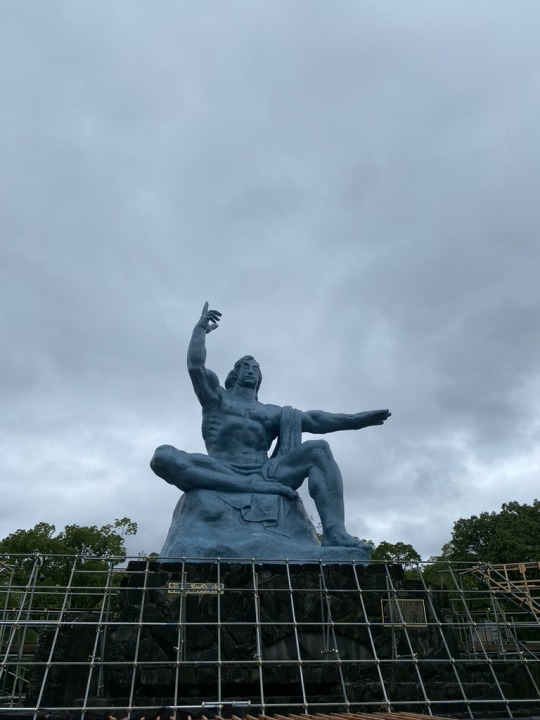Don't wanna be here? Send us removal request.
Text
Take a Train from Hiroshima to Nagasaki This Summer
As I was born in Hiroshima and my grandfather experienced the Hiroshima bombing at the age of 5 on the outskirts of the city, the Hiroshima bombing has been a crucial and relevant historical event for me. I visit the Hiroshima Peace Memorial Museum every chance I get, since childhood, and I offer a minute of silence on August 6 at 8:15 AM watching the Hiroshima Peace Memorial Ceremony on TV every year. So, I’ve grown up reading and hearing Hiroshima literature and relating myself to this horrendous historical event. Last winter I visited the newly-renovated peace museum when I visited my grandparents for New Year’s. But as I walked out of the museum it made me wonder: Why isn’t there any contextualization of the bombing? There is no mention of the Pacific War or anything before August 6. If you look at the webpage of The Hiroshima Peace Memorial Museum, the museum’s mission says: To convey to the world the horrors and inhumane nature of nuclear weapons and spread the message of “No More Hiroshimas” -- through A-bomb artifacts and testimonies of the atomic bomb survivors. NO wonder. Since their mission is dedicated to telling the tragedy of Hiroshima, there is no need to tell a single story about how the war led to the atomic bombing of Hiroshima.
Sheer curiosity took me to the webpage of the Nagasaki Atomic Bomb Museum because unfortunately I had never had a chance to pay a visit there and I wanted to know how Nagasaki does the same. But what I found was an interesting difference between the Hiroshima Peace Museum and the Nagasaki Atomic Bomb Museum. The Nagasaki Atomic Bomb Museum devotes one third of their exhibition to placing the atomic bombings of Hiroshima and Nagasaki not only in the context of Japanese history, but also of the history of nuclear weapons and their development. The war history exhibition, titled “The Road to the Atomic Bombing,” looks from the Manchurian Incident in 1931 to the Japan-China War, and follows up with the Pacific War to the defeat of Japan in 1945. They also have sections for the history of the atomic bomb development (especially the Manhattan Project), the nuclear arms race in the Cold War era, and the danger of testing the atomic bomb. It inlcudes the Daigo Fukuryumaru incident, where a Japanese fishing boat happened to encounter a hydrogen bomb test in Bikini Atoll in 1954, and the radiation damage to uranium miners in the US and the Soviet Union.
Reading through the websites of both museums about the atomic bombing, I came to realize that the two museums have different goals and approaches in their exhibitions. Hiroshima points out the tragedy of Hiroshima and is trying to create the discourse of “No More Hiroshimas”: Nuclear weapons are inhumane and must not be used again because they caused such atrocities in Hiroshima. Nagasaki, on the other hand, takes a comprehensive view. Nagasaki does tell what happened on August 9 as Hiroshima does: A-bomb artifacts, testimonies of Nagasaki survivors are there. But there are sections of exhibition dedicated to contextualizing the Nagasaki bombing in the context of Japanese military history or the history of nuclear power emphasize that Hiroshima and Nagasaki are a part of the nuclear tragedy for human beings as a whole. It resonates with Kyoko Hayashi’s (Nagasaki survivor) remark in From Trinity to Trinity when she visits the Trinity Site in New Mexico: “As soon as I started walking through the small passage within the fenced area led by a guide, my always-present awareness of being a victim disappeared from my mind.” When Hayashi visits the Trinity Site, she comes to feel compassion for Trinity as a survivor of the atomic bomb, beyond the differences of nations, enemy-friends, time, and distance.
I regret that I haven’t ever visited Nagasaki. I thought that the Hiroshima and Nagasaki experiences were similar, and the museums would be similar too. But I was wrong. They do carry different missions and messages, and it is important to visit both places and museums (and the Trinity Site as well) if you want to understand the atomic bombings more completely. A sad thing is that my perspective – visiting only one site (mostly Hiroshima) – is not rare for a lot of visitors, especially foreign visitors. In fact, Hiroshima attracts more visitors than Nagasaki, and the proportion of foreign visitors is bigger for the Hiroshima Peace Memorial Museum: Hiroshima has 1,522,453 visitors (434,838 foreign visitors) in 2018, but Nagasaki attracts 705,314 visitors (including 135,900 foreign visitors) in 2017. I understand that Hiroshima gains more attention because it was the first place that the atomic bomb was dropped on people. Nonetheless, it shouldn’t deprive Nagasaki of the opportunity to convey their message and understanding of the atomic bombings. So, I want to say, take a train from Hiroshima to Nagasaki with me! I’ve decided to visit Nagasaki this summer, as have been tempted to do since I now know what the Nagasaki Atomic Bomb Museum offers us. It’s a 4-hour train trip from Hiroshima to Nagasaki, and I promise that your trip to Nagasaki, combined with a visit to Hiroshima, will give you more perspectives on the history and round out your understanding of the atomic bombings.
A quote is from From Trinity to Trinity by Kyoko Hayashi and Eiko Otake (Translator)
「平和記念資料館、外国人入館者が6年連続過去最多」朝日新聞 2019.4.16
「原爆関連施設の入場者数が増加 核廃絶へ 機運高まり要因か」長崎新聞 2018.5.18
*I wrote this piece in the winter of 2020 and visited Nagasaki later.

1 note
·
View note